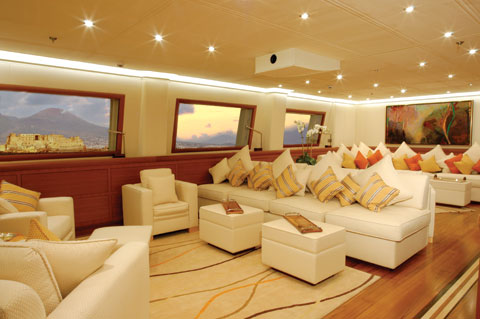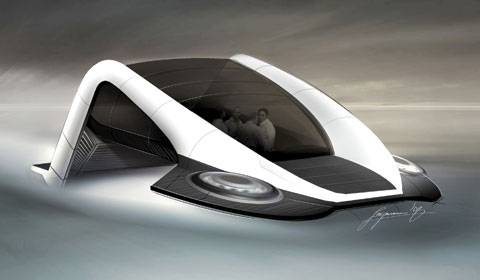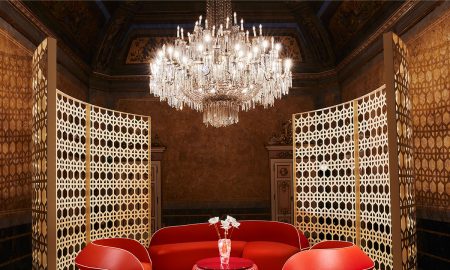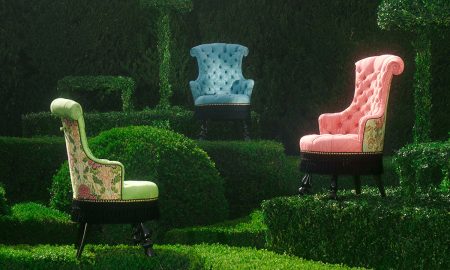Fox Inc. CEO Barry Diller owns one of the world’s most admired sailing yachts. The 305-foot-long Eos, built by Lürssen, bears the distinction of being the largest overall.
When financier Tom Perkins put his tri-masted yacht, the Maltese Falcon, on the auction block earlier this year, the $115 million offering attracted the attention of yachting enthusiasts and neophytes alike. As one of the largest and fastest sailing yachts in the world, the Maltese Falcon and others of similar breeds are drawing a spotlight to the subgenre like never before.
Few images conjure up the good life more than sailboats do. With their sleek hulls and billowing sails, they represent the awe-inducing partnership of nature and nautical design. Significant numbers of megayacht owners are opting for wind-powered vessels rather than motoryachts. For the record, all of the yachts mentioned have full motor function; engineers outfit the craft for maximum performance no matter the wind speed. In addition to the Maltese Falcon, other yacht-spotter favorites include Athena, Eos, and Mirabella V. At harbors from the Caribbean to Croatia, these vessels can be counted on to draw crowds.
Athena is the brainchild of Netscape founder Jim Clark, though his high-tech tastes appear to be at odds with the elegant 1930s era mahogany and teak surfaces. The entire 289-foot aluminum hull is wired with the latest in computer technologies. From control of the sails to noise reduction, this software innovator applied his pioneering spirit to the inner workings of the ship, proving that classic looks can work alongside cutting-edge machinery.
The Mirabella V is the largest single-mast sailing yacht. Her mast makes her the tallest sloop in the world, extending 292 feet—about 30 stories—above the waterline. She is so tall, in fact, that there is no bridge in the world high enough to accommodate the Mirabella V’s passing beneath it. Commissioned in 2003 by Avis CEO Joe Vittoria, specifications included the ability to reach high speeds from a single mast in order to allow for maximum deck space. The interior is also noteworthy for its sheer spaciousness—the hull has enough depth to fit a double-decker bus inside.
Fox Inc. CEO Barry Diller owns one of the world’s most admired sailing yachts. The 305-foot-long Eos, built by Lürssen, bears the distinction of being the largest overall. With the same ingenuity that he brought to so many of his successful business ventures—like Cheers, The Simpsons, and Raiders of the Lost Ark—this media mogul took a front seat in designing Eos, specifying the desired three-masted architecture and sleek profile. With Diane von Furstenberg as his wife, it is not a surprise that Diller takes design seriously. For this undertaking, Diller chose François Catroux, the Parisian decorator nonpareil who has built design interiors for some of the most recognizable names in France and America. Incidentally, this appointment brought the fashion connection full circle; Catroux is the longtime husband of Betty Catroux, aka the late Yves Saint-Laurent’s former muse.
Interestingly enough, size does not seem to be the common denominator for the best sailing yachts. Diller has gone on record saying that he never set out to build the biggest boat, and Tom Perkins has said that his next yacht will be a smaller one. Indeed, part of the sailboats’ charm according to owners, brokers, and charter clients comes from the fact that they feel more intimate than many motoryachts. With sleeping room for 10 to 12 and lengths in the vicinity of 200 feet, the following ships are among the most popular choices for charters.
An achievement in modern design, Parsifal III’s owner knew what he wanted down to the most minute details when he collaborated with Perini Navi for the 2005 launch. Parsifal III is an undisputed beauty with her black hull and glossy wood interior, but rumor has it charter brokers were initially reticent about whether or not the ship would be popular. They feared its modern design was perhaps too bold. From its first season on the market, fears proved unfounded and Parsifal III has been something of a star on the charter scene, with room for 12 and unexpected family-friendly touches throughout its sleek interior.
Georgia was the largest sloop in the world at the time it was built and is in many ways the ultimate family yacht. With four large guest rooms and an ease of sailing that necessitates a remarkably small crew for a ship of its size, privacy is guaranteed. It also comes fully stocked with toys like sailing dinghies, kayaks, scuba equipment, and mountain bikes so that adventures are easy to arrange on land or water.
Selene’s Art Deco interior, constructed in ebony, fries maple, and wengé, brings an unprecedented level of luxury to interior architecture on the high seas. The geometric 1920s style is rendered complete with marble, stainless steel, and leather parchment. Selene was the most talked about sailing yacht launched in 2007, an indication that at least one sector of the market has shifted its focus from size to style.
At 211 feet, Felicità West was the largest aluminum sailing yacht until Eos took over that title this year. Expert builders Perini Navi have plenty of experience achieving “firsts,” but even so, Felicità West required the expertise of Ron Holland, a naval architect who collaborates frequently with the Italian firm (this was the same partnership that brought forth Eos and Parsifal III). Holland is a lifelong sailor and this is evident in the design of Felicità West. The mainmast rises 197 feet in the air and together the two masts carry an impressive 20,000 square feet of sail, ensuring that heads turn when she pulls into the harbor.
A perennial favorite is the 1934 J-Class classic sailing sloop, Endeavor. She was launched to compete in the America’s Cup that year, and though her 130-foot overall length is much smaller than many ships today, she was considered a giant when she was first put in the water. Endeavor was recently re-fit, endowing her Golden Era charms with state-of-the-art navigability. The Endeavor’s evolution from competitive vessel to one intended solely for leisure represents the historical arc of sailboats and their use in the last century.
While competitive sailing remains alive and well, its offshoot—the luxury leisure sailing market—continues to gain momentum with each passing nautical mile.

























